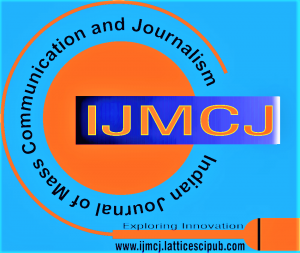A Study on SDG Linkages in the Eco-Hope Series of News Portal Mongabay India
Lekshmi Priya Sanal1, I. Arul Aram2
1Lekshmi Priya Sanal, Research Scholar, Department of Media Sciences, Anna University, Chennai (Tamil Nadu), India.
2Dr. I. Arul Aram, Professor, Department of Media Sciences, Anna University, Chennai (Tamil Nadu), India.
Manuscript received on 17 December 2023 | Revised Manuscript received on 30 December 2021 | Manuscript Accepted on 15 March 2024 | Manuscript published on. 30 March 2024 | PP: 1-15 | Volume-3 Issue-3, March 2024 | Retrieval Number: 100.1/ijmcj.C106703030324 | DOI:10.54105/ijmcj.C1067.03030324
Open Access | Editorial and Publishing Policies | Cite | Zenodo | OJS | Indexing and Abstracting
© The Authors. Published by Lattice Science Publication (LSP). This is an open-access article under the CC-BY-NC-ND license (http://creativecommons.org/licenses/by-nc-nd/4.0/)
Abstract: Even after eight years since the birth of UN Agenda 30 and its 17 sustainable development goals (SDGs), climate change and its varying effects continue to loom over the earth and its inhabitants. How well are the SDGs covered by the media and communicated to the masses in a way that may evoke action and participation? The goals actively advocate for participation at global, national, and regional levels but, most importantly, at grassroots as well as individual levels. The knowledge that individuals or communities practising sustainable ways of living and livelihoods may go a long way in aiding other communities if adapted on a needs and context basis. The role of journalists and communicators becomes crucial here when such stories combined with the SDGs have the power to draw attention to not just the perils of global warming, or climate change but also, the idea that solutions to mitigate these exist. However, media coverage of SDGs or actions taken by various nations towards achieving these goals has been nearly negligible worldwide; with general environmental reportage itself, being rarely taken up in the mainstream media. To make environmental news more approachable, a constructive approach that includes context and examines solutions rather than focusing only on problems is the need of the hour. The role of alternative media platforms that particularly focus on environmental issues proves crucial here. One such platform in India is Mongabay India, whose Eco Hope series focuses on highlighting efforts and solutions towards environmental conservation. This paper studies linkages between SDGs emerging in 133 feature stories of the Eco Hope series and takes a mixed method approach to identify the linkages through content and thematic analyses.
Keywords: Sustainable Development Goals, Constructive Journalism, Environmental Communication, Solutions Journalism.
Scope of the Article: Communication
